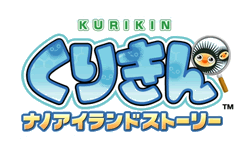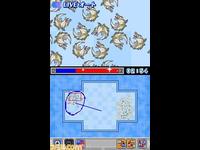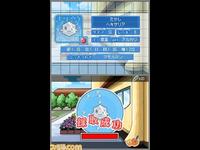|
|

|
PLATFORM
|
DS
|
BATTLE SYSTEM
|

|
INTERACTION
|

|
ORIGINALITY
|

|
STORY
|

|
MUSIC & SOUND
|

|
VISUALS
|

|
CHALLENGE
|
Moderate
|
LANGUAGE BARRIER
|
Moderate
|
COMPLETION TIME
|
20-40 Hours
|
|
OVERALL

|
+ Ridiculously cute germs.
+ Catchy music that matches the game's pace well.
+ Some interesting cast characterizations.
- Plot is still a cookie-cutter railroad.
- Player often has to go into battle blindly.
- If you don't like the stylus, then...
|
Click here for scoring definitions
|
|
|
Sometime last year, I came across Kurikin: Nano Island Adventure in an out-of-the-way store. I was looking for something specific at the time, so I made a note to check it out at a later time at one of my more regular stores. Well, none of them had this game, which made me even more curious. Finally I trekked back to that first store to pick it up.
Kurikin falls squarely into the monster-collecting sub-genre, but from the start it manages to stand out. Whereas most such games focus around getting big, impressive creatures to fight with (e.g. monsters, dinosaurs, bugs, etc.), Kurikin swings toward the diminutive end of the scale with various microbes. The name schemes in the game don't really distinguish between viruses, bacteria, and protists, and these little germs bear no resemblance to any microbes found in nature anyway.
The game is set on the mysterious Nano Island, a hidden corner of the earth where for generations the locals have exercised control of the local micro-biosphere to improve the quality of life. There are microbes to strengthen mortar, microbes to influence the taste of food, microbes to clean water, even microbes to use as a cold remedy. Many new discoveries have come courtesy of the Bacterian Lab, but lately odd things have occurred all across the island. The main character knows nothing of this, having just transferred to the local grade school from his or her prefecture in Japan. Despite being a complete novice, the main character will need to learn the ropes fast, as literally everyone on the island is obsessed with germ warfare.
Speaking of which, combat in this game is quite different. When the combatants measure in microns, the humble petri dish becomes a field of battle. Combat is real-time, with the player circling and directing microbial armies as they try to surround and engulf the enemy. Initially all combat is one-on-one, pitting single colonies of germs against each other, but a few chapters into the game two-on-two battles become the norm. Winning conditions include Domination (control 50% or more of the field by the end), Extinction (total wipeout of enemy side), Goal (get as many germs as possible past a certain point), or Boss (targeting an abnormally large germ on the other side). Battles may last anywhere between one and five minutes. One major downside is that in story battles the player most often will not have any idea what the opponent will be fielding. Even if a battle is lost due to not meeting the winning condition in time, microbes gain experience from the numbers of enemy germs wiped out. In the worst case scenario in a story battle, however, having an entire microbe colony wiped out means the player loses that one permanently. Judicious reloading may be necessary on occasion, as some of the major villains can be a shock to the unprepared.
 Pot is bad, mmmkay?
Pot is bad, mmmkay?
|
|
As this game is very much an RTS in style, it should come as no surprise that the stylus is a must-have item here. The regular buttons can be used to navigate menus or select locations on the map, but that can be done just as easily with the stylus. Fortunately, the stylus controls in battle are simple and intuitive. The game will even complete circles for the player, as long as two-thirds or so of the arc is finished.
There are over one hundred twenty varieties of germs, though the last twenty or so are of limited availability for trading purposes. Some are stronger, some are tougher, some spread faster, and some move more quickly. No single strain has high numbers in all of these stats, and different tactics work better with different types. They come in three size categories — S, M, and L — with some correlation between size and stat balance.
The main determination of strengths and weaknesses is made in a traditional rock-paper-scissors fashion with every germ being either a Solid, a Veil, or a Sword type. One other thing to take into consideration is a germ's preferences for heat and pH, as some petri dishes have different base settings. Finally, each microbe has a special skill, activated by an item that appears from time to time in the dish, which can either boost stats or inflict damage to an area.
 Unfortunately, this isn't a lycanthropy virus.
Unfortunately, this isn't a lycanthropy virus.
|
|
All in all, it's a system designed to encourage mixing and matching. There is a free-battle location available where one can practice without fear of negative outcomes, and some of the battles there prove excellent for building levels. The other characters all use a variety of microbe types, petri dishes, and ambient conditions. The game's AI also improves noticeably according to the supposed skill level of the opponent.
Getting back to the storyline, this game has some good character development for a monster-collecting title targeting grade schoolers. The cast is filled with the usual character types, but three in particular are of such importance to the plot that they could well have been the main characters instead of the player's silent protagonist. There are even points where the player may let the other characters take on villains, giving them a bigger part in some scenes. The plot itself is fairly straightforward, as it alternates between "beat this character" and "find a particle microbe" with only a few deviations. The nature of the game's true villain is perhaps its best twist, though the secondary villain lineup has some good points. It's not every day when a game casts grandmotherly apothecaries and grade school art teachers as villains, and manages to make them decent foes at that.
While there's nothing truly exceptional about the game's soundtrack, it's fast-paced and fits the game's RTS battles to a T. In a game where everything is in motion, slow or introspective music just wouldn't cut it. Fast and gleeful seems to be the norm here.
 Look under the microscope... See?
Look under the microscope... See?
|
|
Kurikin is not an exceptionally long game. Twenty-one hours is just about enough to beat the main story, while the post-game Microbe Battle Tournament keeps the player engaged after that. It's interesting to note that this game includes something that isn't normally found in DS games — achievement trophies in the style of PlayStation games. Getting the "Ultimate Microbe Maniac" trophy (raise all 128 types of germ to level 99) would take half past forever.
In a sea of monster-collecting titles, this is one that is so striking and different that it deserves a second glance. Unfortunately, it seems to have met the same fate as the vast majority of such titles, that being the back shelf, the bargain bin, and obscurity. This is one game whose germ of an idea could have been contagiously popular. It just failed to sprout. In the end, it serves as an interesting example of what can be done within a genre known for its generic output. I really hope I find someone else with this title some day, just so I can see how I do against a real, live opponent. It really does not require much Japanese skill to play, so import gamers might be well served to check this one out if they have the opportunity.
Review Archives
|









